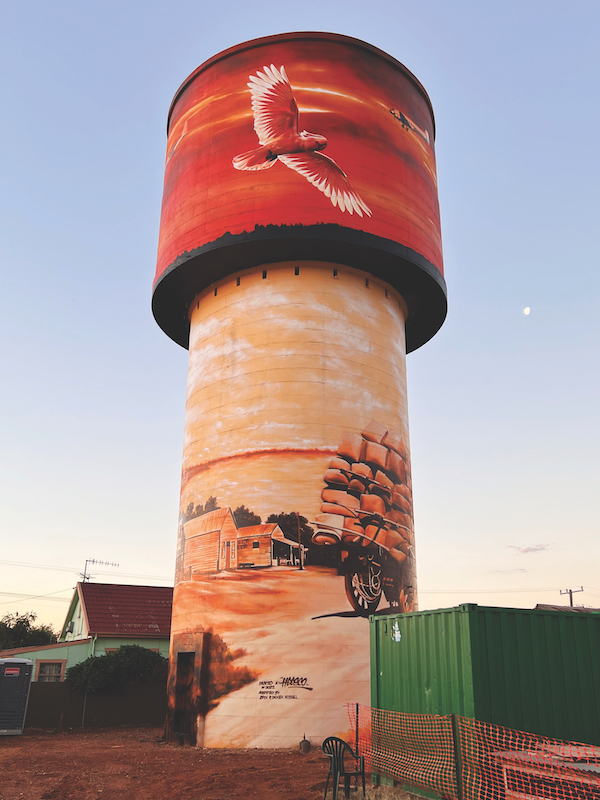With its huge architectural curvatures acting as a canvas, the white sails of the Sydney Opera House have played host to numerous temporary projections of artwork. Most recently, The Great Animal Orchestra by Bernie Krause and United Visual Artists was projected on this grand scale to celebrate the opening of rīvus, the 23rd Biennale of Sydney. Previously in 2021, the third instalment of the Badu Gili series was projected on the sails, bringing important First Nations stories and culture to the public in a spectacularly accessible visual format.
On a smaller and more permanent scale, painted murals are consistently materialising throughout our urban spaces and suburban streets. Melbourne-based mural artist Heesco recently completed jaw-droppingly large murals in Gunnedah and Lake Cargelligo in New South Wales transforming the rural towns. Infusing a vibrant energy in our communities, murals pose the question – if you are in possession of a blank wall, how would you go about filling it with art?
Get permission
Check with your city council first. Each council has its own regulations when it comes to putting custom art on exterior walls. Generally, a mural is defined as writing, painting, drawing, etching, pasting or stenciling on private or public property. Once you have approached your local council, your chosen artist can prepare a digital mock-up of the mural and how it will appear on your property.
Commissioning
Find an artist whose work you connect with and who clearly has experience in creating large scale imagery. A walk around your neighbourhood will most likely reveal hidden murals and you can often find an artist’s name or social media handle embedded in the image. Contact the artist to check their availability and fees and have an idea of what you’d like the mural to contain.
For Hobart-based Jamin, an artist who has worked in public art for several years, the mural process always begins with conversation. “Even if the client and I are from different walks of life and have different key interests, there are always intersections and common grounds to be discovered. This could be a sense of colour, or formal elements or subject matter.”
The importance of place
The mural site determines how the art will work with a space and the time it will take to complete. Geelong-based artist Jasmine Mansbridge is known for her 3D geometric murals and she explains, “All surfaces require a different amount of time to prepare and paint. A brick wall is a lot more intensive to paint than a standard plaster board wall. It’s important to have an idea of what you can afford so we can talk about how to bring a vision to life.”
In addition to the quality of the intended surface, surrounding architectural elements also come into consideration. Artists might need to work around corners, windows and doors and this can determine how a mural will be applied. Even with extensive pre-planning, remain flexible with the creative process and embrace the unexpected. As Jamin admits, “When painting on large objects, the objects themselves tend to have a bit of an opinion on how things should go.”
Communal joy
Whether an architecturally-inspired abstract pattern, a collection of local flora or a portrait of a prominent local, a mural can completely change the vibe of a space. “I love that art and architecture can work together in dynamic and interesting ways, and how the flow of hand-made lines can soften and humanise the stark edges of construction,” says Jamin.
Most importantly, murals can bring a neighbourhood together. Sparking conversation, the visual delight a mural can bring goes a long way in fostering a sense of community and belonging, often in a mutually beneficial way.
“With site-specific work, an artist comes to paint a mural and leaves feeling like they are part of the fabric of that locality,” says Mansbridge. “While working, you have coffee in the cafes, eat the local food and meet the people who live there. You leave art for the community. It’s something people will see every day and that’s such a privilege for me.”

